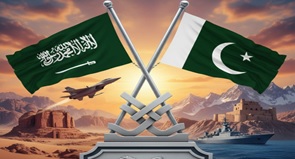23 September, 2025
Saudi-Pakistan Defence Pact
Tue 23 Sep, 2025
Context
- In a significant geopolitical development, Saudi Arabia and Pakistan have signed a Strategic Mutual Defense Agreement (SMDA), formalising a decades-old but largely informal military relationship. This pact includes collective defence mechanisms, joint military coordination, and intelligence-sharing—making it a comprehensive security arrangement that can potentially reshape regional dynamics.
What is the Pact About?
The SMDA offers:
- Joint defence clause similar to NATO-like frameworks.
- Real-time intelligence sharing and defence coordination.
- Military modernization support from Saudi Arabia for Pakistan.
For Pakistan, this agreement serves both as financial relief and strategic legitimacy. For Saudi Arabia, it provides a hedge against regional threats from Iran, the Houthis, and broader instability in West Asia.
Implications for India
- Strategic Challenge in West Asia: The pact poses a geopolitical setback to India’s Gulf diplomacy. It could embolden Pakistan to push its narrative on Kashmir within organisations like the Organisation of Islamic Cooperation (OIC), thus complicating India’s standing in the Islamic world.
- Energy Security Risks: Saudi Arabia is one of India’s largest crude oil suppliers. This deeper Saudi-Pakistan alignment may add friction to India’s energy cooperation, especially if diplomatic tensions arise.
- Indian Diaspora Concerns: With over 2.6 million Indians in Saudi Arabia, any shift in Saudi foreign policy or labour norms could impact remittance inflows and the safety of Indian nationals.
- Counter-Terrorism Setbacks: India’s efforts to isolate Pakistan on terrorism charges may now face resistance, as Riyadh’s stronger strategic bond with Islamabad could dilute their cooperation with India in forums like UNSC or FATF.
- Risk of Arms Race: Saudi financing may enable Pakistan to rapidly upgrade its military capabilities, including in areas like AI-driven drones, hypersonic weapons, and cyber warfare—pressuring India to respond with higher defence spending.
Why Saudi Arabia Matters to India
| Parameter | Importance for India |
| Energy | 2nd largest crude oil supplier to India |
| Trade | India-Saudi trade volume exceeds USD 43 billion (2023) |
| Diaspora | 2.6 million Indians, major remittance contributors |
| Defence | Joint exercises (e.g., Al Mohed Al Hindi, EX-SADA TANSEEQ) build interoperability |
| Geopolitics | Saudi support vital for India-Middle East-Europe Corridor (IMEC) |
| Green Economy | Collaboration in hydrogen, solar, FinTech & AI under Saudi Vision 2030 |
India’s Strategic Response
1. Deepen Economic Diplomacy with Saudi Arabia
India must double down on projects like:
- West Coast Refinery
- Strategic oil reserves
- Tech & FinTech collaboration
This ensures ties are economy-driven, not Pakistan-influenced.
2. Rebalance via Iran and INSTC: A revitalised engagement with Iran, especially using Chabahar Port and INSTC, can help India bypass Pakistan, maintain strategic reach to Central Asia, and offer an alternative to Chinese corridors.
3. Strengthen Look West Policy
India should expand defence and energy partnerships with:
- UAE (energy & counter-terrorism)
- Qatar (LNG)
- Oman (naval base access)
This hedges India’s interests against a Saudi-Pakistan axis.
4. Leverage Mini-lateralism: Frameworks like I2U2 (India-Israel-UAE-USA) give India leverage as a non-threatening, stabilising partner in West Asia.
Saudi Arabia and Pakistan
| Attribute | Saudi Arabia | Pakistan |
| Capital | Riyadh | Islamabad |
| Currency | Saudi Riyal (SAR) | Pakistani Rupee (PKR) |
| Head of State | King Salman bin Abdulaziz Al Saud | President Asif Ali Zardari (2025) |
| Head of Government | Crown Prince Mohammed bin Salman (MBS) | Prime Minister Shehbaz Sharif (2025) |
| Major Religion | Islam (Sunni majority) | Islam (Sunni majority) |


















